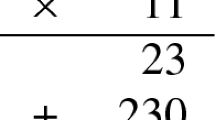Abstract
Mathematics researchers put considerable cognitive effort into trying to expand the body of mathematical knowledge. In so doing, is their cognitive behaviour different from those who work on more standard mathematical problems? This paper attempts to examine some aspects of mathematical cognition at the highest level of formal functioning. It illustrates how the structure of a mathematician’s output—and, to a certain extent, its cognitive complexity—can be characterised by the SOLO taxonomy. A number of cognitive and philosophical issues concerning mathematical functioning at the research level will also be discussed.
Similar content being viewed by others
References
Aziz, A., & Zargar, B. A. (1998). On the critical points of a polynomial.Bulletin of the Australian Mathematical Society, 57, 173–174.
Biggs, J., & Collis, K. F. (1982).Evaluating the quality of learning: The SOLO taxonomy (Structure of the Observed Learning Outcome). New York, NY: Academic Press.
Biggs, J., & Collis, K. F. (1989). Towards a model of school-based curriculum development and assessment using the SOLO taxonomy.Australian Journal of Education, 33, 151–163.
Campbell, K. J., Watson, J. M., & Collis, K. F. (1992). Volume measurement and intellectual development.Journal of Structural Learning, 11, 279–298.
Case, R. (1985).Intellectual development: Birth to adulthood. Orlando, FL: Academic Press.
Chick, H. L. (1988). Student responses to a polynomial problem in the light of the SOLO taxonomy.Australian Senior Mathematics Journal, 2, 91–110.
Chick, H. L. (1996a). Rings with isomorphic additive and circle composition groups. In B. J. Gardner, L. Shaoxue, & R. Wiegandt (Eds.),Rings and radicals (pp. 160–169). London: Longman.
Chick, H. L. (1996b).Aspects of the circle composition operation in rings. Unpublished PhD thesis, University of Tasmania.
Chick, H. L., Watson, J. M., & Collis, K. F. (1988). Using the SOLO taxonomy for error analysis in mathematics.Research in Mathematics Education in Australia, May–June 1988, 34–47.
Coady, C., & Pegg, J. (1994). Tertiary students’ understanding of second order relationships in function notation. In G. Bell, B. Wright, N. Leeson, & J. Geake (Eds.),Challenges in mathematics education: Constraints on construction (Proceedings of the 17th annual conference of the Mathematics Education Research Group of Australasia, Vol. 1, pp. 179–186). Lismore, NSW: MERGA.
Coady, C., & Pegg, J. (1995). Students’ use of second-order relationships in algebra. In B. Atweh & S. Flavel (Eds.),Galtha (Proceedings of the 18th annual conference of the Mathematics Education Research Group of Australasia, pp. 189–194). Darwin, NT: MERGA.
Collis, K. F., & Biggs, J. B. (1983). Matriculation, degree requirements, and cognitive demands in universities and CAEs.Australian Journal of Education, 27, 151–163.
Collis, K. F., & Watson, J. M. (1991). A mapping procedure for analysing the structure of mathematics responses.Journal of Structural Learning, 11, 65–87.
Commons, M. L., Richards, F. A., & Armon, C. (Eds.). (1984).Beyond formal operations: Late adolescent and adult cognitive development. New York, NY: Praeger.
Fischer, K. W., & Sylvern, L. (1985). Stages and individual differences in cognitive development.Annual Review of Psychology, 36, 613–648.
Gleick, J. (1985, December 8). The man who reshaped geometry.The New York Times, Section 6, pp. 64,112–124.
Hadamard, J. (1945).An essay on the psychology of invention in the mathematical field. Princeton, NJ: Princeton University Press.
Hungerford, T. W. (1990).Abstract algebra: An introduction. Philadelphia, PA: Saunders College Publishing.
Piaget, J. (1950).The psychology of intelligence. London, England: Routledge & Kegan Paul.
Shalen, P. (Ed.). (1997). Editorial information.Transactions of the American Mathematical Society, 349(10), back end papers.
Stillman, G. (1996). Mathematical processing and cognitive demand in problem solving.Mathematics Education Research Journal, 8, 174–197.
Taft, E. J. (Ed.). (1997). [Aims and Scope.]Communications in Algebra, 25(7), inside front cover.
Taplin, M. (1994). Development of a model to enhance managerial strategies in problem solving.Mathematics Education Research Journal, 6, 79–93.
Truesdell, C. (1951). Review of the paper “Equations of finite vibratory motions in isotropic elastic media. Surface force sufficient to maintain equilibrium” by G. Garcia.Mathematical Reviews, 12, 561.
University of Tasmania. (1997).Research higher degrees handbook, 1998. Hobart, TA: Author.
Watson, J. M. (1994). A diagrammatic representation for studying problem-solving behavior.Journal of Mathematical Behavior, 13, 305–332.
Watson, J. M., Chick, H. L., & Collis, K. F. (1988). Applying the SOLO taxonomy to errors on area problems. In J. Pegg (Ed.),Mathematical interfaces (Proceedings of the 12th biennial conference of the Australian Association of Mathematics Teachers, pp. 260–281). Armidale, NSW: AAMT.
Watson, J. M., & Mulligan, J. (1990) Mapping solutions to an early multiplication word problem.Mathematics Education Research Journal, 2(2), 28–44.
Author information
Authors and Affiliations
Rights and permissions
About this article
Cite this article
Chick, H. Cognition in the formal modes: Research mathematics and the SOLO taxonomy. Math Ed Res J 10, 4–26 (1998). https://doi.org/10.1007/BF03217340
Issue Date:
DOI: https://doi.org/10.1007/BF03217340




